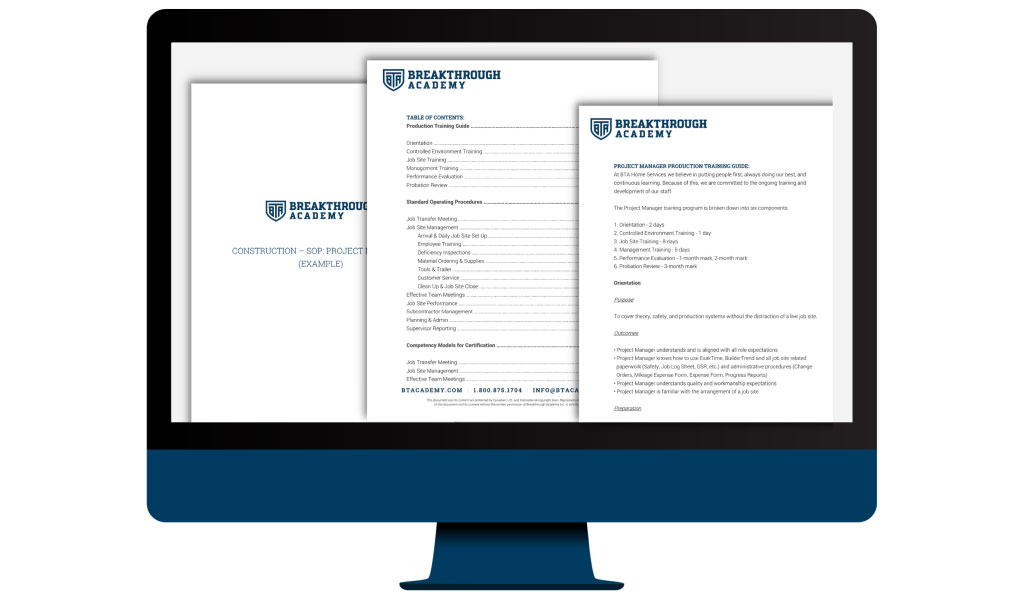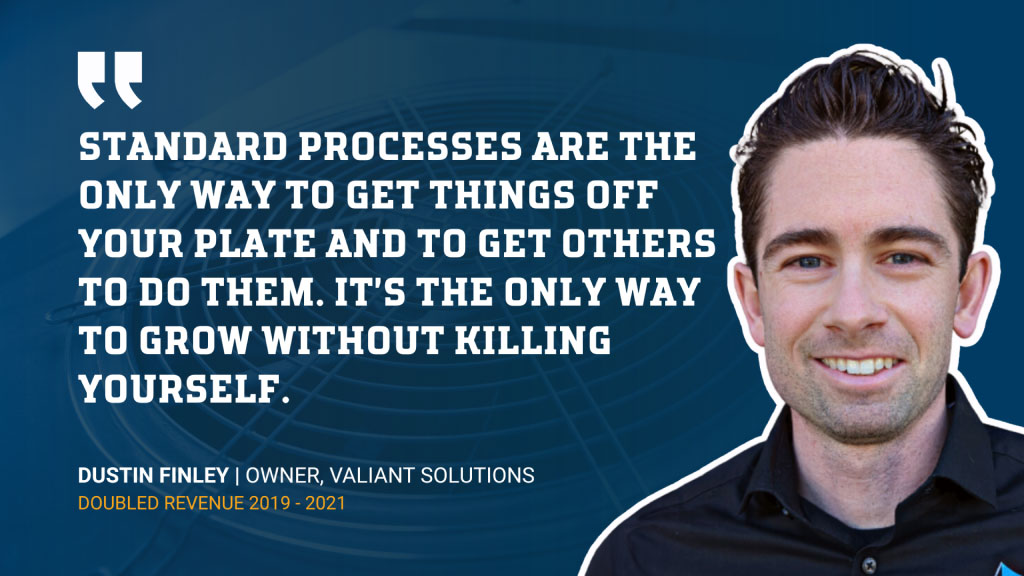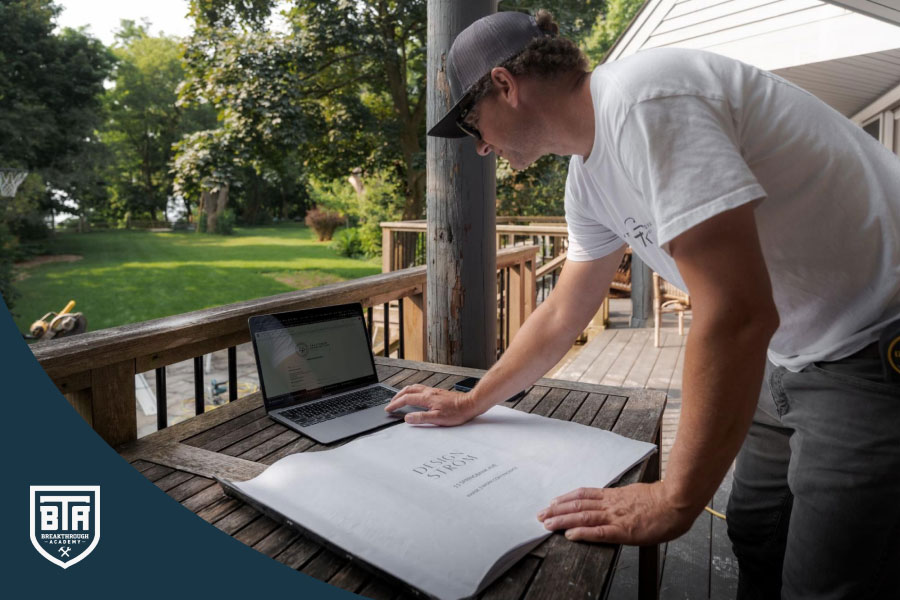Do you feel like you’re trying to outwork a dysfunctional business? Drowned by demoralizing waves of customer emails, buried under an avalanche of dumb calls, and piddly profits. Better Standard Operating Procedures might be the key – because you can’t outwork a dysfunctional business (although many contractors have died trying).
You’ve been running your business for a while now, and you’re busy. But it feels like it’s with all the wrong things. Between chasing down project updates, double-checking invoices, helping your team put estimates together… you’re exhausted.
And no matter how often you explain things, yours is still the door everyone knocks on when they need answers. Or worse, they don’t even bother asking at all and just go off and do things their own way.
It sounds like you need some standard operating procedurezzz…
Hang on.
Before you drift off, hear us out. You can’t be the one fielding every question, handling every detail or putting out every fire. You’ve got bigger stuff to focus on. Like your company’s vision.
You need to extricate yourself from the day-to-day craziness. In this article, we’re going to show you how standard operating procedures (SOPs) can enhance your business and improve your life. Once we’re done, you won’t be nodding off, you’ll be raring to get writing.
Buckle up.
S-O-whaa?
Let’s start at the top. What exactly is a standard operating procedure? For a solid definition of these under-appreciated little suckers, we turn to Tom Hughes, GembaDocs co-founder and author of Improvement Starts With I.
An SOP is a clearly documented, understood, and agreed-upon way of carrying out a task.
That’s it. It’s basically how stuff gets done. Buuuut, there are a few key elements in Hughes’ definition that are worth digging into. A good SOP should be:
- Documented – It’s time to share the wealth… of knowledge. Get your processes out of everyone’s heads and onto paper, a Google doc, a flow chart, heck, even an iPhone video. What really matters is that it’s captured in a centralized place.
- Understood – Not only should the process be written out, it needs to be done so in a way that’s easy to make sense of.
- Agreed upon – The process can’t be made up, or only one person’s idea of how something should be done. It has to be the actual method everyone’s aligned with.
To learn more about Tom Hughes’ life-changing approach to SOPs, and how GembaDocs can help you create SOPs in minutes, listen to Episode 78 of the Contractor Evolution podcast.
Now that we’ve laid out the definition, let’s delve a bit further. SOPs generally fall into two categories:
- How-To’s – These explain the simple tasks that people tend to do infrequently, but are super annoying to remember or interrupt someone about.
💡 Think: How to mix chainsaw fuel, change a printer cartridge or ship a box.
- Essential Processes – These describe the everyday tasks you really don’t want to mess up because they’re important to the functioning of the business.
💡 Think: The process for assembling a product, raising an invoice or closing a deal.
Handle the contractor chaos
Still not convinced SOPs can make a substantial impact on your business operations? How many of these bullet points make you twitch?
- Your estimating process is inefficient, and your team reinvents the wheel with each one.
- Getting bids out the door drains way too much energy.
- The tech solutions you’ve got are convoluting things instead of streamlining them.
- If you can even find the labor you need, you don’t have time to train them.
- Scheduling is a nightmare. You’re constantly herding cats.
- Your sales team’s execution could best be described as “varied.”
- You do have a few systems for your operations. You’re just the only one who knows them.
Dealing with menial administrative demands and getting bogged down in day-to-day operations takes you away from more important matters: strategy, culture, landing big clients… you know, the big stuff! Without SOPs, quality inevitably suffers, and it becomes nearly impossible to scale.
Ready to rein in the chaos?

Check out Breakthrough Academy’s Web Class (featuring the man himself, Tom Hughes) to learn the latest wisdom from contractors who have experienced dramatic revenue growth and drastically reduced stress levels by implementing SOPs.
But where do I even start?
Here’s some good news. Whether you realize it or not, you’re probably already running your contracting business with some standard operating procedures.
- Do you use any checklists? Those are basically SOPs. Boom. Yup, that counts.
- Repeating yourself (…again…)? That’s a good candidate for an SOP. Boom. There you go.
- Next time you’re explaining something to someone, have them take notes. Boom. Another one drafted.
See? You’ve got ‘em… you just need to write ‘em down.
Each SOP will inevitably be driven by an intention. Whatever it is, don’t make it a secret.
Need a few more ideas on where to begin?
Find a mirror.
That’s right. If you want to start dumping expertise onto the page, the best place to begin is with yourself.
To help you prioritize, start with the stuff that annoys you the most. Or, in the words of 2 Second Lean author, Paul Akers: Fix what bugs you.
What causes you headaches? Those are great candidates for SOPs. Consider topics such as:
- Scripts for what to do when field staff arrive on site.
- How to close a sales call.
- How to put together a winning estimate.
- Quality control inspections that ensure nothing gets missed.
- Safety protocols for specific sites.
If everything’s in your head, you make yourself the biggest bottleneck, so download your processes first.
🚧 Pro tip: Construction project management software like Knowify can help you create and put SOPs into practice by giving you a standardized workflow to follow for recurring processes like creating contracts, invoicing, logging time, and so on. When a process is built into a piece of software, it’s easier for your team to follow.

Breakthrough Academy has a bunch of SOP templates, which are available in the on-demand SOP web class. It’s about 10x faster to tweak them to your liking than to write them from scratch! They’re inviting you to plagiarize their work… seriously!

How do I get my team to use them?
Maybe you’re sitting there thinking, you’ve been around this tree before. You put a bunch of processes together and now they’re sitting in a binder in the back of a truck being used to scrape off dirty boots.
Getting your team to adopt and follow SOPs is probably the hardest part of the whole endeavor, but it’s not impossible. With these suggestions, teams can even become enthusiastic champions of SOPs (no joke!).
Bottom up, instead of top down
It might seem simpler to make SOPs a DIY project, but involvement brings buy-in because people more easily remember and follow processes they helped create. Not to mention, most of the best stuff comes from the ground level. You have blindspots to how things get done. While it may seem unrealistic to get your carpenters to crush out an entire SOP, at the very least, book a call and have them brain-dump everything they know for you (or someone else on your team) to assemble.
Explain the WHY
There’s a concept in the army called the “commander’s intent,” which is a succinct statement of purpose designed to be easily understood by all personnel involved in the mission. Each SOP will inevitably be driven by an intention. Whatever it is, don’t make it a secret.
Sell how it helps them
When it comes down to it, implementing systems is essentially a sales job. People are more prone to adopt a change if it truly improves their lives. Getting staff on board is much easier if they know what’s in it for them. For instance, with clear SOPs in place, team members can go on holiday confident that whoever’s covering for them knows what to do.
At point of use
SOPs are more likely to be used when people don’t have to hunt endlessly to find them. Make them available at the place where they’ll be needed, whether that’s physical or virtual. GembaDocs has a cool feature using a QR code that opens the latest version of the SOP online.
Build a culture around them
This starts with hiring people that fit your company’s values. Layering in proof-of-completion measures, like photos or checklists, makes team members accountable to each other and frees you from having to police the process.
🚧 Pro tip: Knowify can help you create a culture around your SOPs. With reusable task lists, photo logging, automated daily job logs, and time tracking tools, you create the SOP, and Knowify provides tools to support it.
Keep them up to date
This is an important one because people lose trust in SOPs when they’re outdated. But when team members are given ownership of their processes, they tend to take pride in them and keep the documentation up to date.
SOPs keep the tires turning, even when you’re no longer behind the wheel.
Do’s & don’ts of SOPs
As you embark on your SOP journey, here are some points worth bearing in mind.
| DO | DON’T |
|---|---|
| ✅ Create an SOP Index. This is a master list of all the SOPs you expect you’ll need. Add to it as you encounter other processes. ✅ Have someone test the SOP. When the same person who carries out a process is the one writing it, they can forget steps that have become implicit or intuitive for them. ✅ Trust your team. Once SOPs are ingrained in your business, your staff will build on them as they go. ✅ Have newbies take a breath. Give new people a month to settle in and learn the ropes before they start drafting (or changing!) your SOPs. | ❌ Don’t overcomplicate it. You don’t need a 10-page SOP when a one-pager will do. It’s a procedure, not War & Peace. ❌ Don’t outsource it. It can be tempting to just bring someone in to bash these out, but you’ll have better buy-in if you keep it in-house. ❌ Don’t let perfect be the enemy of the good. SOPs don’t need to be pristine right out of the gate. They can evolve. And they should. ❌ Don’t make updates an annual event. Avoid only updating your SOPs once a year. It should be ongoing, with people engaged in doing it for their own benefit. |

The big benefits
Still awake? Good. Because we’re going to reveal a couple massively overlooked benefits of SOPs.
Hiring and onboarding
Clear processes mean that you can reap rewards at every stage of the hiring process:
- Expand the talent pool. If you can’t get experienced labor, you may need to hire greener talent. SOPs make training them a lot easier.
- Integrate faster. SOPs allow new hires to quickly get familiar with how things are done without needing to draw on other people to explain everything.
- Reduce mistakes. If new hires have clear guidelines to follow, you’ll avoid hearing the phrase, “Oops… I didn’t know that…”
- Lower turnover. When staff are onboarded smoothly, they’re more likely to stick around because they start feeling like a contributing member of the team sooner.
Generally speaking, people want to work where expectations are clear, and directions are straightforward. SOPs actually bring teams closer, building dedicated and engaged employees. Your team will feel the efficiency, and it will create momentum. Far from resenting the SOPs, they’ll be thrilled to have them. Like the satisfaction of a perfectly level shelf, you appreciate it most when it’s being used.
🚧 Pro tip: Consolidating your processes with software like Knowify can help with employee onboarding and retention. Knowify gives your team repeatable processes to follow, which is way safer than hoping they learn from the rest of the crew, who may (or may not) be doing things the best way…
The younger generations entering the trades grew up using software in school and in their personal lives. A system like Knowify will feel familiar to them, allowing them to get up to speed faster… and it creates a sense of transparency and collaboration across your team.
Team changes future ready
If your future plans for your company involve selling it some day, one of the first items potential buyers will look for is whether you have SOPs in place, and whether they’re being followed.
Well-entrenched operating procedures also mean that the company can continue running smoothly without you, which is the most essential element when you sell. SOPs keep the tires turning, even when you’re no longer behind the wheel.
Finally find peace in the chaos
The frenzy of being a grass-roots entrepreneur can be exciting, but you’ll need to calm that down if you want to become an enterprise-level business owner who’s not constantly bombarded by demands from every direction, at all hours.
We get that SOPs are boring. But embrace the boring. Boring means satisfied customers, stronger profits, and less stress. There’s bliss in the bland.
Maybe we should rename them Soothing Operating Procedures…

Watch Breakthrough Academy’s on-demand SOP Web Class to hear from an expert who has mastered the art of implementing SOPs.
Want to learn how Breakthrough Academy helps contractors implement these resources — and scale up with less stress? Get in touch to book a chat and dive into your business needs.
